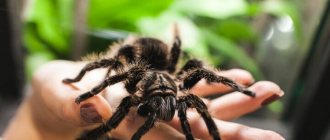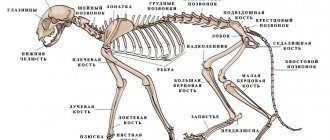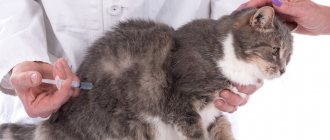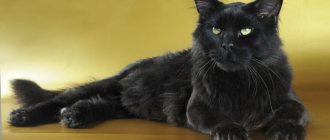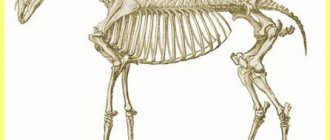Cats have a flexible fold of scruff on the back of their heads, which has a special structure, and doctors use it to treat animals. This withers in a cat is located in the place where the cervical region meets the spine. During illness, doctors inject precisely into this area. It is important for the pet owner to know about it; you need to take the animal by this fold carefully and in special cases.
What is the withers and where is it located?
The withers are located on the back of the animal's head in front of the shoulder blades, which are not difficult to feel with your hand. The body in this area is arched, since the first 5 cervical vertebrae are located under the skin and fat layer. With the help of muscles and tendons, the neck is connected to the body, so this fold is elastic and can be easily separated from the muscle tissue. Thanks to these structural features, namely flexibility, cats perform complex jumps; height is not an obstacle. Despite the fact that the scruff of the neck has a thick layer, there are few nerve endings in it, this is the best place for injections.
Is it possible to carry adult animals in the same way?
Small pets do not feel pain when their mother lifts them by the fold of skin in front of their shoulder blades. Their weight is very small, and there are few sensitive cells in the skin at the withers. Under the layer of fatty tissue in the withers area there is a group of muscles. The shoulder blades are connected to the body only by tendons. This gives cats extraordinary flexibility and the ability to perform complex jumps. However, adult animals weigh several times more than kittens, so you should not lift them by holding them by the front paws or the scruff of the neck.
If you pick up an adult cat by the withers, you can injure his skin, as it becomes very stretched under the weight of the cat. With such a grip, the skin can also crush the pet's throat. In addition, there is a risk of neck injury. You need to understand that an adult cat experiences discomfort when picked up by a fold of skin. It can scratch its owner.
When grabbed by the scruff of the neck, the pet may decide that the person is showing his superiority, since such a position makes the animal practically defenseless. This may cause him stress. Some cats perceive such treatment as disdainful, so they may begin to take revenge on the owner. It is best to lift adult animals by placing your hand on the chest between the front legs. This way the pet will feel comfortable and will not get injured.
Why is it needed?
By nature, the withers have the ability to paralyze the motor activity of the animal when exposed to it. This occurs when receptors inside the fold work; they send impulses to the brain, activating the function of stopping movement. This ability allows the animal to freeze at the right moment, while the pet has the ability to carry offspring without creating noise.
In kittens, there is a section in the cerebellum that is responsible for balance in the air. When they are taken by the scruff of the neck, the brain receives a signal from the cerebellum that it needs to behave calmly and assume a fetal position. Therefore, the cubs are not hurt, they calmly react to such manipulations.
During the training process, in order to convey information to the animal, you need to grab the withers and slightly press the pet to the floor.
The scruff helps owners in matters of raising tailed animals; she is responsible for their behavior. With the correct influence on the fold, it is possible to carry out educational actions on a pet. If the pet does not obey, misbehaves, or shows aggression, the owner must firmly grasp the withers and slightly press the cat to the floor. In this case, it is necessary to quietly but confidently tell the animal that this cannot be done. The main thing to remember is that adult cats should not be lifted by the scruff of the neck; it may hurt them.
How to influence a naughty pet using his own scruff?
Reflexes associated with the withers persist in cats throughout their lives. You cannot lift pets weighing 3–5 kg or more by the scruff of the neck, but you can use their natural instincts for educational purposes and in the training process.
By properly grabbing the scruff of the neck, you can prevent fights between cats, and also stop your pet from crapping in the wrong places or sharpening its claws on upholstered furniture. Experts consider such actions more effective than punishment. To re-educate your pet, you need to apply the following algorithm:
- Firmly but gently grab the cat by the fold of skin on its neck. It is important to control your grip strength. The animal should not experience pain. We need to make him understand that he is not the strongest and the person in this house is the main one. Holding the scruff of the neck will force the pet to obey.
- Press the aggressor to the floor, continuing to hold him by the scruff of the neck. Say the prohibition word: “no”, “impossible”. You must speak clearly, firmly, but calmly, without raising your voice. Screaming in this case is unacceptable. It’s better to copy the behavior of a disgruntled cat and hiss at your pet. This signal has been familiar to him since childhood. This is how the mother made it clear to the baby that she did not like his behavior.
- Hold the cat until he relaxes. You can speak to him in a calm tone to help him calm down. Typically, pets need no more than 5 minutes to realize their guilt.
- Release after complete relaxation, praise, caress, removing your hand from the withers. For obedience, you can treat the obedient animal with a treat.
For some animals, one educational act is not enough to improve. In this case, the actions must be repeated if a similar situation arises. As a result of several repetitions, the pet will understand what the owner does not like.
Source
Why are medications applied to the withers?
The back of the head is used to treat a pet; it is suitable for subcutaneous injections. Injections into this area are more effective; the drug is absorbed into the blood faster due to the elasticity of the fold. The animal does not experience severe pain during medical procedures. The scruff is used in the fight against fleas and helminths in pets, but it is not available for licking off the medicine. Special anti-parasite drops are placed on the back of the head. There is no need to bathe the kitten after applying the drug; touching or stroking this area is contraindicated - the applied drug can cause poisoning.
Application rules:
- Wear gloves.
- Grasp the withers and spread the fur.
- Apply the medicine to the cartilage protrusion.
- Grind the preparation so that it does not spread.
Interesting facts about the cat's scruff
One of the most interesting facts about a cat's scruff is that it contains special receptors. When there is interaction between them, the cat automatically relaxes its torso and presses its paws towards it. Such receptors are especially active in cats at a young age, and thanks to this, mother cats calmly carry them by the withers from one place to another. However, it is not advisable for owners of large cats to treat them in this way, since only a cat is capable of carrying kittens by the withers without leaving damage.
Also, the skin on the nape of the neck is quite thick and almost not sensitive due to the minimal number of nerve endings. It is thanks to this that the scruff of the neck is the most convenient and safest place for a cat to carry out subcutaneous injections. When the injection is made taking into account all the rules, the cat will feel practically nothing.
Note! The cat will feel virtually no discomfort or pain if the procedure is performed correctly and in accordance with veterinary standards. That is why most drugs for various diseases and skin parasites are designed specifically for injection under the skin of the neck.
Interestingly, during reproduction, males hold females by the scruff of the neck.
Thus, it was sorted out where the cat’s withers are, what functions it performs for the animal itself, and how the scruff is useful for people. The place is noteworthy in that it is possible to place droppers there or give injections, since it does not contain a large number of nerve fibers, and such procedures are easily tolerated by animals. In addition, a cat's scruff is also useful in nature. The female always carries her cubs in her teeth, and so that they do not hurt and do not move, she has to take them by the withers. It is completely painless, and the animal instantly assumes the fetal position.
Diseases, injuries and treatment
The pet can injure the withers at the time of mating. In such a situation, you need to treat it with brilliant green or peroxide, then trim the hair around the damage and apply a bandage. The fold is a significant area of the body; if it is inflamed, swollen, or red, you should immediately contact a veterinarian. You should not inject antibiotics yourself; only the doctor knows which ones and how hard the syringe is injected under the skin. Next to the scruff is the neck. You can injure the back of the head if you lift or drag the cat by the withers, as children do. Damage to the cervical spine can lead to serious health problems for the animal and even death. It is necessary to take it by the fold carefully.
Symptoms
One of the main signs of lichen is spots without fur.
There are a number of common symptoms for all types of lichen in cats:
- hair loss;
- peeling and inflammation of the skin;
- change in pigmentation;
- inflammation;
- severe itching.
Symptoms of ringworm
With ringworm, a cat loses certain areas of its fur. But the disease begins with a barely noticeable small rash under the fur. Signs that should alert the owner are increased anxiety of the animal and frequent scratching. The development of ringworm in cats is characterized by the following:
- round flaky spots appear on the skin, crusts form;
- the fur in the areas where the rash appears thins, the hairs become brittle;
- smooth, reddened skin is visible under the fallen scales;
- the spots expand and take an oval shape;
- the spread of serous-purulent crusts leads to the formation of scabs;
- the areas of skin underneath are completely missing hair; after recovery, it will not be restored;
- If the cat is not treated, the spots will grow, forming extensive areas of baldness.
The spots are painful, itchy, and cats often chew and scratch them. There is also a form of ringworm in which all the described signs are either absent or clearly not expressed. This clinical picture is called atypical. Only individual hairs of the fur are affected. Ringworm is invisible, therefore, a person does not take any measures until the disease is already advanced.
Ringworm symptoms vary depending on the specific pathogen. In some cases, only the cat's head and face are affected, in others the spots spread to the entire body.
Ringworm in cats
Symptoms of versicolor (pityriasis versicolor)
Tinea versicolor initially looks like a small pale oval spot on the skin of a cat or cat. But after a few days the number of spots increases, they grow together, forming lesions of irregular shape. If the fungus gets into the claw, it becomes deformed.
Interestingly, there is practically no itching with this form of lichen. And when it gets colder, the spots may disappear on their own. The affected surface can be either smooth or scaly. Otherwise, pityriasis versicolor is practically no different from its other types.
Pityriasis versicolor in cats
Symptoms of pink (shingles)
Pityriasis rosea can appear as many small spots like an allergic rash, or it can appear as large pinkish spots up to 2 cm in diameter. Most often, lesions appear on the stomach, inner thighs, and groin of the animal. The itching may be slight or sometimes absent altogether.
In the center the spots are flaky, and at the edges the skin is smooth. In severe cases and without treatment, sepsis may occur if pathogenic microorganisms enter and take root in the lesions. Sometimes pityriasis rosea in a cat is accompanied by fever, joint pain, swollen lymph nodes, and general malaise.
Pityriasis rosea in cats
Symptoms of weeping lichen (wetting eczema)
Ringworm in cats and kittens also begins with red spots. The skin in these areas is hotter than the surrounding area and is also very painful. The rash consists of blisters filled with fluid. When these blisters rupture, their contents are released, causing skin infection and the formation of ulcers and crusts. Sometimes shingles is accompanied by a fever. This type of disease is not dangerous for people.
Lichen planus
Division into types depending on the pathogen
Symptoms and treatment for mange in cats depend on the type of mite. According to this criterion, 4 types of disease are distinguished.
Otodectosis
The causative agent is the tiny ear mite Otodectes cynotis. The maximum size of its body is only 0.75 mm. It affects the outer and inner parts of the ear. Distinctive signs of otodectosis are severe ear itching, the appearance of a nauseating smell of rot and dark grains inside the ears. An infected cat constantly shakes its head and rubs its ears against any objects.
Demodicosis
Demodex canis is a cigar-shaped parasite that is light gray in color. The length of its body is 0.2-0.3 mm. Unlike other pathogens, it lives in the sebaceous glands and hair follicles from the moment the animal is born. The development of demodicosis occurs with a sharp drop in immunity.
According to the degree of damage, there are 2 forms: localized and generalized. In the first case, the diameter of the lesions is no more than 2.5 cm, in the second, the disease affects most of the body. The localized form often goes away on its own and responds well to drug therapy. The chance of recovery from chronic demodicosis depends on the complications that arise. When a secondary infection occurs, they drop to 50%.
Depending on the symptoms, demodicosis can be scaly or pustular. In the first case, redness and cracking of the skin is noted, in the second - the appearance of suppuration and ulcers. The danger of generalized demodicosis is in the combination of scaly and pustular forms. The disease is accompanied by severe complications and is difficult to treat.
Sarcoptic mange
Sarcoptes scabiei is a broad-oval tick that is white-yellow or completely white. The length of the smallest representatives is 0.14 mm. They affect the entire surface of the body and cause sarcoptic mange. You can suspect their appearance by thin light gray lines with a small bubble at the end that appear on the affected areas.
Notoedrosis
Notoedres is a round, dirty gray parasite. The length of its body is 0.5-0.45 mm. Most often it affects the outer side of the ears. In this case, dark gray discharge with a foul odor appears from the ears. Due to liquid secretions, the fur sticks together and takes on an unkempt appearance. The disease is called pruritic scabies, or notoedrosis.
Varieties of lichen
The general name “lichen” hides various diseases with similar manifestations.
Ringworm is fungal in nature, contagious to humans and especially dangerous for children. It is also called “trichopytosis”, “microsporia”, “cat lichen”. Fungal spores are very stable in the external environment. For example, in flakes of exfoliated skin they remain viable for 6-10 years. In the soil, spores die in 2-3 months, and at home they can be active from 2 months to a year and a half. They settle on surfaces, feeling especially good on textiles. Interestingly, ringworm can be transmitted not only from cats to humans, but also vice versa.
Pityriasis versicolor, or pityriasis versicolor, is also a dangerous fungal disease to which humans are also susceptible. It is also called “sun fungus” and “beach lichen” due to the fact that it reaches its greatest distribution in the summer. The causative agent is the yeast-like fungus Pityrosporum. About 90% of people in the world are its carriers, and it is also present on the skin of almost any animal. Under certain conditions, the fungus turns into a pathogenic form, causing the development of lichen in cats. The provoking factor is disruption of the sebaceous glands, which results in excessive oily skin. You are especially likely to get sick in hot, humid weather.
Pink, or shingles, is of an allergic nature and manifests itself when the immune system is weakened. It is considered non-infectious and harmless to humans, however, scientists do not have a consensus on this matter. There is reason to believe that pityriasis rosea may be caused by some virus that has not been clearly studied at the moment. The disease is inherited, and after recovery it sometimes returns with renewed vigor, so it is better to limit the contact of a sick cat with people, especially children and the elderly.
Ringworm, or eczema, is a non-contagious type of lichen that manifests itself in cats as an allergic reaction to some irritant. This can be an external influence, for example, household chemicals, detergents, or internal factors, such as hormonal imbalance, stress. For humans, this type of lichen is not dangerous.
Where should I put flea drops on my cat?
The main condition when treating an animal against parasites is that the medicine should be dripped onto those areas of the skin from which it will not be licked off later. Therefore, it is best to apply the drops to the space between the back of the head and the shoulder blades. The drug is dripped onto dry, clean skin; the fur should first be parted. After the procedure, it is not recommended to comb or wash the cat for 2-3 days.
Short tail
It is noteworthy that the presence of a tail in a “rudimentary” state or its complete absence in cats is a sign of “noble” origin (in contrast to the same domestic dogs, whose tails are docked deliberately - to fit the animals to the standards of a particular breed). It is worth noting that there are only a few types of short-tailed/“tailless” cat breeds, which include:
Kurilian Bobtail
a short curved tail approximately 5-9 cm long, resembling a fluffy pom-pom and characterized by mobility, a relatively small body with strong bones, developed muscles and limbs of medium length, a triangle-shaped head with medium-sized eyes corresponding to the color, short-haired or semi-long-haired, but in in any case, with a fluffy collar on the neck and chest.
more details
American Bobtail
a short and flexible tail from 2.5 to 8 cm long (it can be straight, curved, and slightly curled at the end), a body of medium length with an athletic build and strong paws proportional to it, a round muzzle with strong jaws and ears, an internal the surface of which is covered with long fluffy hairs, short or long hair, but always thick and slightly harsh.
more details
Japanese Bobtail
a short tail no more than 12 cm long (straight, curled, curved or in the form of a pompom), a long and lean body with a flat back and slender legs (the hind legs are noticeably longer than the front ones), a muzzle with large oval-shaped eyes and large, wide-set ears, soft and silky coat of medium length.
more details
Mekong Bobtail
a short and broken tail with a length of at least three vertebrae (but no more than a quarter of the length of the body itself), a strong and muscular body of medium size with long legs, a wedge-shaped head with medium-sized ears (with rounded tips) and slightly slanted eyes, always bright blue , short silky coat with minimal undercoat.
Karelian Bobtail
a short tail 4-13 cm long (can be either kinked or almost straight), a strong body with an even posture and proportional paws, a narrow head with a small strong chin and rather large ears with tiny “tassels”, short or long hair ( necessarily dense).
Kurilian Bobtail
“no, not a relative”
short tail 3-8 cm long (with pronounced kinks), strong build with a slightly arched back and powerful paws, large trapezoidal head with a powerful chin and proportional ears, short or long hair (very soft to the touch).
more details
Pixiebob
short straight (but possible kinks) tail about 5 cm long, large and muscular body build with powerful bones and a clearly defined arch on the back, large pear-shaped head, tightly knit and strong paws (the hind legs are noticeably longer than the front ones), short or moderately long hair with different color options, but always with small or medium spots throughout the body.
more details
Manx cat
they may either have no tail completely, or have a small “stump” hidden under the fur, or generally have a tail of normal length, a medium-sized round body with a round head, powerful limbs with well-developed muscles (the front ones are noticeably shorter than the back ones), round eyes with a slight slant, short and thick coat, like “plush”.
more details
Cymric cat
Kymrik
tailless breed (but there can be either a “stump” or even a full tail), a tightly built physique with a wide chest and an arched back, short front and long hind limbs (with heavy shins), thick hair of medium length.
more details


